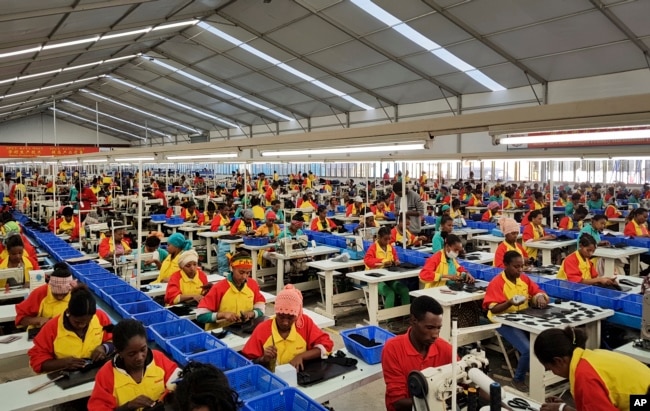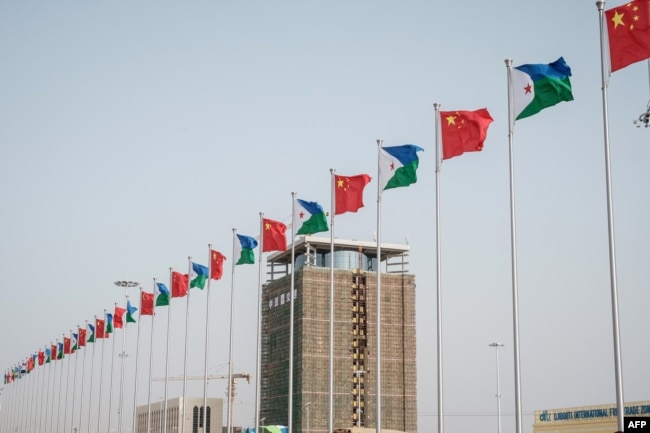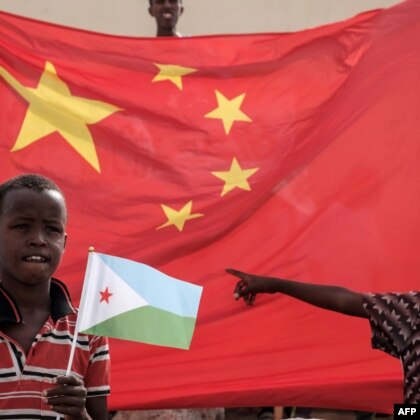FILE - A boy holds the Djiboutian national flag in front of the Chinese national flag before the launching ceremony of China-financed 1,000-unit housing construction project in Djibouti, July 4, 2018. (AFP)
Voice of America
With a Positive Spin, Chinese News Outlets Cover Africa
In Rwanda, a Chinese-owned garment factory provides jobs to hundreds of local workers. In Ethiopia, a Chinese-built railway makes life easier for business owners and travelers. In Zambia, a Chinese-funded television project will bring satellite TV to 500 villages.
Each of these stories, published by Xinhua, China’s state-run news organization, typifies the country’s coverage of Africa.
Rather than focus on corruption or disasters, China’s news about Africa emphasizes positive angles, especially when it comes to the Communist Party’s deepening involvement across the continent.
It’s a media strategy that highlights China’s mutual interests with Africa and reflects its broader approach to soft power, even if the whole story isn’t told.
Positive news angles
In Chinese media, “what comes across is the government’s interests,” Emeka Umejei, a research associate in the Department of Journalism and Media Studies at Wits University in Johannesburg, South Africa, told VOA.

FILE - Ethiopian factory workers make shoes at Chinese company Huajian’s plant in Addis Ababa, Ethiopia, Jan. 5, 2017.
Chinese news organizations don’t perpetuate outright disinformation, Umejei said, but coverage of Africa is shown in a positive light when stories implicate China. That amounts to propaganda, according to Umejei, because the goal isn’t just to inform, but also to shape perceptions of the ruling Communist Party.
Unlike Western outlets, which tend to focus on corruption, misdeeds and transgressions, Chinese media highlight good things happening in Africa.
One example is Kenya’s Standard Gauge Railway, a project financed, built and managed by China.
Local media have reported on a range of concerns tied to the railway’s impacts on Kenya’s wildlife, economy and workers.
Last month, the Sunday Standard, one of Kenya’s largest and most reputable newspapers, published an exposé on the treatment of African workers involved with the railway.
In the report, the Standard alleged widespread racism, discrimination and mistreatment of Kenyans, based on interviews with locomotive drivers and other workers.
The news wasn’t acknowledged in Chinese media. Instead, its coverage of the SGR has focused on the benefits the project brings to Kenya.
In a recently published opinion piece, He Wenping, a senior research fellow at the Charhar Institute, a think tank focused on China’s foreign relations, underscored how well the SGR has moved people and freight.

FILE - Demonstrators protest the route of Standard Gauge Railway (SGR) being built by Chinese government, which is to cut through the middle of the Nairobi National Park, at a rally outside the People’s Republic of China Embassy in Nairobi, Oct. 17, 2016.
“The Mombasa-Nairobi Railway has also greatly facilitated the mobility of people between Mombasa and Nairobi, and the freight transport time has been shortened from more than 10 hours to more than 4 hours, thus reducing the logistics costs by over 40 percent,” she wrote.
Paying dividends?
Some research suggests that China’s soft power campaign and media strategies are working.
Afrobarometer, an African research network, reported in 2016 that about two-thirds of Africans see China’s influence as “somewhat” to “very” positive. And more African countries now see China — not the U.S. — as the biggest foreign influence.
In 2017, Pew Research found that 72 percent of Nigerians viewed China favorably — a higher percentage than any other country polled. More than half of respondents in Senegal, Tanzania, Tunisia and Kenya also reported favorable sentiments.
Chinese media
Chinese news organizations are large, centralized and well-funded.
Xinhua is the country’s official news agency, with English reports published across the web via a network of affiliates.
In research published in 2011, Junhao Hong, a professor at the University of Buffalo, concluded that Xinhua evolved from a pure “propaganda machine” in the late 1970s to a multifaceted enterprise concerned with generating revenue, serving the Communist Party’s interests and producing news for a worldwide audience.

FILE - National flags of China and Djibouti are seen in front of Djibouti International Free Trade Zone (DIFTZ) before the inauguration ceremony in Djibouti, July 5, 2018.
Xinhua’s distribution partners include state media in Africa. Fana Television, a state broadcaster in Ethiopia, has republished or relied on reporting from nearly 20 Xinhua news stories since the beginning of the year.
China Central Television, or CCTV, is the most dominant broadcast news organization. In March, the Communist Party announced it would merge CCTV with two other broadcast entities to streamline operations and enable what Umejei called a “unified narrative.”
‘Win-win’ coverage
In China, “investigative reporting isn’t allowed,” Umejei said.
That means the powerful aren’t held to account. But it also creates space for uplifting stories that show another side of Africa. It’s an approach that resonates with African audiences, Umejei said, given what can come across as a fixation in Western media on Africa’s problems.
Unrelenting stories about conflict, famine, disease and corruption have led to criticism that Western portrayals of Africa, at times, play to outmoded stereotypes, perpetuate myths and underrepresent positive developments.
China has taken a different tact with what Umejei calls a “win-win” media strategy that puts both Africa and China in a flattering light. The strategy also complements China’s approach to soft power in Africa, wherein it frames itself as a benevolent partner with similar goals and challenges.
But critical coverage has an important role in the new ecosystem, according to Umejei.
Investigative journalism is “good for Africa” because it holds powerful people accountable, he said.
This story originally appeared on voanews.com. (August 8, 2018)
